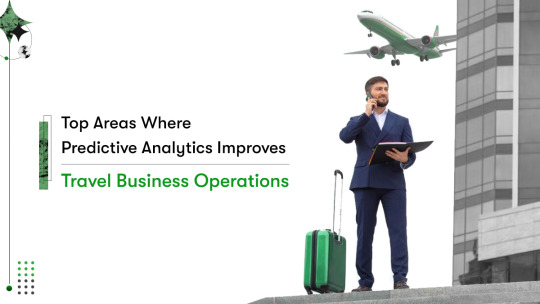#PredictiveAnalyticsinTravel
Explore tagged Tumblr posts
Text

Why Should We Consider Using Predictive Analysis in Travel?
This is a combination of past data along with present-day data, artificial intelligence and statistical models to forecast customers' expectations and market conditions in the travel industry. It is an evolutionary transformative approach that assists travel businesses in performing efficiently and providing customers with solutions tailored to their needs.
How Does Predictive Analysis Work in the Travel Industry?
The concept of predictive analysis for the travel industry is the use of complex patterns and statistical information from the past to estimate future actions, behaviors, and trends of consumers. The benefits of this technology are, therefore, increased efficiency of resource use and improved customer experience and revenue.
What Predictive Analytics is used in the Travel Industry?
Analytical models and artificial intelligence are incorporated with statistical methods in predictive analytics to analyze data about the past and the present in the travel industry. This enables travel companies to forecast customer requirements and market development and even enhance their organizational effectiveness.
Data-Driven Decision-making Significance & Impact in Travels
This business intelligence tool guides travel organizations in making the right strategies by examining past customer data, market situations, and external circumstances such as climate or economic circumstances. This makes it possible for businesses to maintain their flexibility in highly competitive business environments.
Personalization Using Forecasting
Personalization is one of the main uses of predictive analytics. An understanding of customers’ needs helps travel businesses decide on such strategies as marketing messages, promotional destination suggestions, and variable high/low price options.
Improving Company’s Performance
Sensitivity to operational efficiency is another advantage. Airlines forecast their maintenance requirements so that unnecessary airplane out-of-service time is minimized whilst optimizing employees in a hotel to suit expected room use, leading to better service delivery and cost efficiency.
What are examples of predictive analytics in travel?
Several cases of Predictive Analysis in Travel reflect its applicability to various business issues, including the pricing strategy along with customer acceptance. Here are some details of this application across the industry.
Dynamic Pricing Strategies
Pricing for products or services is continually changing to meet the demand, influenced by features such as time of year, customer preferences, and trends. This happens in air ticketing services and hotel reservations.
Predicting Travel Demand
Predictive analytics relies on historical information as well as inputs received in real time to predict the demand for individual places or services. It enables travel companies to plan inventory and marketing ahead of time.
Customer Retention Analysis
Travel organizations apply big data techniques to switch customers who are likely to churn, and they do that by offering special loyalty programs or individual offers.
Managing Operational Risks
Aviation managers and transportation companies use forecasting techniques to prevent possible disasters like weather disturbances or equipment breakdowns and ensure a proper flow of operations.
Marketing Campaign
They aid marketing to get the optimum value for the amount invested to reach audiences that are likely to respond to a given campaign.
What Is AI for Predictive Analytics in Travel?
AI for predictive analytics in travel aims to analyze large volumes of data and extract patterns and insights that are useful in predicting travel trends. This is because it allows the business to double the ways through which it can better deliver, operate, and even forecast the market far better than any conventional.
What Are the Use Cases of Predictive Analysis in Travel?
Examples of the application of predictive analytics across the travel industry range from operational optimization to engagement. Looking at the data, challenges, and opportunities can be identified, and travel companies can then respond.
Airline Flight Plan / Flight Path Optimization
Predictive analytics helps airline companies fix the best routes and time to save costs and satisfy their customers.
Customer loyalty programs as a concept
Travel companies use the predictive model to create efficiencies in loyalty programs that appeal to regular traveling clientele.
The art of destination marketing needs to be enhanced.
Marketing departments within tourism boards and travel companies look for trends in data for the best places tourists are likely to visit when spending their money on travel and then market accordingly to avoid wasting the most amount of money on a particular place that no one wants to visit.
Conclusion: How Predictive Analysis Shapes the Travel Industry
The broad concept of using advanced data analysis to drive better decision-making, improve customer satisfaction, and improve operational performance has reshaped the travel industry. This is a strategy that enables a business entity to forecast the market needs and allocate resources in an appropriate manner to be in a position to design and deliver unique products to the market, hence very relevant to the current market environment.
However, in the future, as the industry moves forward, predictive analytics will be of higher importance when facing some of the issues, including demand volatility, organizational inefficiencies, and customer loyalty. Drawing upon the concepts of AI and machine learning, travel firms can forecast developments, control possible adverse effects, and ultimately tap into new sources of revenue.

2 notes
·
View notes